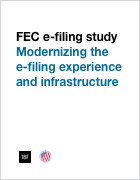Modernizing the E-filing experience and infrastructure
2016 E-Filing study prepared by 18F
The objective of the study was to understand how the FEC can modernize the e-filing system to get better quality data, be responsive to user needs, and handle increasing volumes of data.
The FEC’s work revolves around campaign finance reporting by political committees, candidates, and groups. These filings provide the data that supports the FEC’s transparency mission. Over the past two decades, as records have evolved from paper to microfilm to databases and APIs, filing has moved from a paper-based process to a process that depends heavily on software. The FEC engaged 18F to conduct this study of electronic filing (e-filing) in order to look forward and prepare for users’ changing needs.
Overview and the E-Filing process
In order to understand the e-filing process, we interviewed and observed dozens of people, including those who file reports to the FEC, people in various job roles at the FEC, and vendors of commercial campaign finance software. While these stakeholders that comprise the e-filing ecosystem may have different missions within their own organizations, they all play critical roles in helping the FEC achieve its mission of publicly disclosing campaign finance activity.
1. Make changes in a human centered, open, and agile way
The FEC has been successful in revamping fec.gov using an agile, human-centered approach. Our primary recommendation for improving the e-filing system and experience is to continue and extend this approach. This will help ensure any changes to the e-filing experience and infrastructure are based on evidence that they will improve user experience. An open source, API-driven approach will also help the FEC expand their use of industry-leading software development practices and make it easy for commercial campaign finance software to incorporate these improvements. Incremental changes with frequent usability testing can help ensure that the FEC is continuing to best serve the wide range of people who depend on its data.
2. Help filers report correctly
We found that filers often want to report correctly, but struggle to do so. Even data power users like journalists pointed to filer confusion as a cause of data errors. Filers spoke of a desire to file correctly the first time so they would not have to amend reports, receive requests for additional information, or handle calls from the press.
One of the most powerful ways to make the filing process more intuitive is to make the FECFile software more usable, and we recommend improvements to FECFile in this report. Helping filers complete forms correctly is critical because it improves their experience and improves the experience for other users of the data both inside and outside the FEC.
3. Help those who help the filers
FEC staff help improve data quality and the filer experience by helping people file correctly. Some filers also take advantage of a robust vendor community that integrates with FEC tools to help filers. Vendors often offer filing as part of a broader suite of products and services that make running a campaign easier, so making it easier for vendors to integrate with FEC tools is an effective way to improve the experience for filers, vendors and data users. In our research, supporting those who help filers complete reports successfully emerged as an important means of ensuring accurate data.
4. Ensure future filing reliability
Notably, while our study revealed ways that the FECFile interface and software could be enhanced, filers and vendors articulated few concerns with the overall e-filing infrastructure’s reliability. This is praiseworthy: the FEC has, through evolving practice, timely fixes, and sustained attention, kept the system working under substantially increased load. In coming years, the FEC will need to support increasing volumes of data while maintaining performance and reliability. To do this, the FEC needs to expand existing work to streamline data flow and build for scalability in the long-term.
Some of this work will be tied to development processes. For example, increasing testing and automation can make the development process smoother and more resilient. In other cases, changes to the filing process — such as making data-gathering less error-prone — can help reduce load on the system. Likewise, mitigating the impact of large paper filings, which are more costly and less accurate than electronic filings, would yield data quality dividends as well as improving maintainability.
Infrastructure choices can also support exponential growth; creating a cloud-based system will allow the system to scale up or down to adapt to spikes in traffic and use.
In some cases, (such as for larger structural changes) technology and interface design plays a smaller role and higher-level agency and legislative approvals will be necessary to fully address the problems.
Technical roadmap and software development process
This section augments the recommendations throughout the 2016 e-filing report regarding the types of design and infrastructure changes we believe will help modernize the e-filing experience and infrastructure by laying out more details of the proposed software development workflow and a rough roadmap for next steps in upgrading the infrastructure.
Research methods
We conducted our research in three phases. In the first phase we conducted background research, interviewed and observed stakeholders to understand the current e-filing process and areas for improvement. In phase 2 we developed design concepts that we believed had the potential to make the process better, and then we had users evaluate these concepts via usability testing. In phase 3 we conducted a survey of all e-filing users to learn more about how they would feel about specific changes the FEC might want to make.
